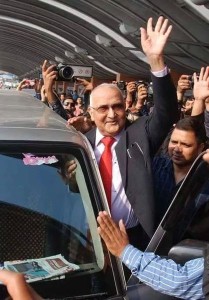South Asia: New Constitutions, New Beginnings
 Prime Minister of Nepal, KP Sharma Oli, recently concluded a six-day state visit to India to “normalize the past uneasy situation and also to further promote age-old ties” in the wake of multiple protests held in reference to the country’s new constitution. According to Prime Minister Oli, clearing misunderstandings to improve bilateral ties was first on the agenda. However, defending the new constitution, which is opposed by Indian Madhesis, remained a key focus.
Prime Minister of Nepal, KP Sharma Oli, recently concluded a six-day state visit to India to “normalize the past uneasy situation and also to further promote age-old ties” in the wake of multiple protests held in reference to the country’s new constitution. According to Prime Minister Oli, clearing misunderstandings to improve bilateral ties was first on the agenda. However, defending the new constitution, which is opposed by Indian Madhesis, remained a key focus.
At an address at the International Conference of Asian Political Parties (ICAPP), Oli asserted that “the new constitution promulgated on September 20, 2015 was inclusive and democratic, as it has all the features of a democratic constitution including guarantee of human rights, independent judiciary, social justice and equality.” The Constitution has been endorsed by 85% of the Constituent Assembly since. Before the creation of the new document, which was delayed in 2010 and not completed until late 2015, Nepal had not had a working constitution since 2007.
However, the new constitution is accused of being gender discriminatory, especially in regards to citizenship provisions. For instance, the same standards for passing citizenship to offspring are not held constant among men and women. If a Nepali woman marries a foreigner, any offspring from such a union would not be considered citizens, while if a man had a foreign wife, citizenship would be granted to his offspring. The citizenship measures established by the new constitution are believed to disproportionately affect Madhesi communities, since they are located on the border of India and cross-border marriage is quite popular.
Additionally, Madhesi and other indigenous populations have claimed that the new constitution fails to address demands of marginalized communities and instead supports the status quo of the ruling majority. For example, the federal delineation of seven new territorial states is feared to lead to further marginalization by affecting the proportional representation (PR) system. It is predicted that a smaller percentage of parliament will now be elected by PR, dropping from 58% to 45%. The PR system is known to have helped members of indigenous and low-caste groups get elected in the past – a key issue for minority groups such as the Madhesi.
With ongoing protests since August 15, 2015 or earlier, at least 45 people, including 8 security personnels and one Indian national, have been killed. Such violence does not bode well for a country just starting to get its democratic processes in order.
Just last week, Sri Lanka, a country in the region with a history of ethnic conflict and civil war, announced the process of drawing up a new constitution. Prime Minister Ranil Wickremesinghe of Sri Lanka proposed that Parliament be converted into a constituent assembly that would discuss and draft the new constitution in the hopes that the country could avoid another civil war. Since its independence from Britain in 1948, the country has suffered from chronic conflict between the Sinhalese majority and the Tamil minority.
It remains to be seen whether a new constitution will solve age-old problems in Nepal and Sri Lanka. Certainly, Nepal has seen difficulties enacting such a process, as shown by the Indian establishment of a blockade on supplies between their borders. The creation of two new constitutions, both within moments of the other, suggest a growing recognition and urgency in both governments of the issue at hand. As neighbors to the “largest democracy in the world,” Sri Lanka and Nepal may be hoping to emulate India’s democratic system. However, ethnic divisions are hard to address, and as Nepal has learned, even harder to ignore.
